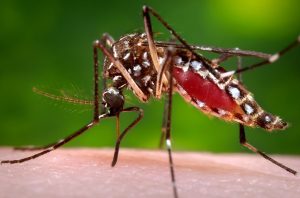29
Sep
Miami-Dade County’s Aerial Spraying of Naled for Zika Virus Shown To Be Ineffective
(Beyond Pesticides, September 29, 2016) A study released last week shows that Miami-Dade County’s aerial spraying of naled for Zika virus produced little reduction on the female Aedes aegypti populations throughout the area. According to the study, Efficacy of Aedes aegypti population control methods in the first two mosquito-borne Zika transmission zones in Miami-Dade County, Florida, within three days of spraying, the mosquito population were virtually identical to the pre-spray levels. The author, Philip Stoddard, Ph.D., is a biology professer at Florida International University and mayor of South Miami.
“Application of permethrin, a persistent pyrethroid adulticide, had no effect whatsoever on mosquito counts. Naled, a potent organophosphate adulticide applied aerially, produced a transitory suppression in Wynwood but lost efficacy after two or three applications,” said Dr. Stoddard. “In Miami Beach, aerial application of naled produced no significant reduction of the Aedes aegypti population.”
Naled is an organophosphate insecticide with the highest acute toxicity of any mosquitocide. According to the U.S. Environmental Protection Agency (EPA), naled can cause cholinesterase (an enzyme necessary to the transmission of nerve impulses) inhibition in humans, meaning that it can overstimulate the nervous system, causing nausea, dizziness, confusion, and, at very high exposures (e.g., accidents or major spills), respiratory paralysis and death. Local residents throughout Miami-Dade have repeatedly expressed their concerns about the county’s use of toxic chemicals to combat Zika, worried especially about the health of their children. Dr. Stoddard’s study puts further emphasis on how rushing to use ineffective pesticide spraying to solve Zika problems exposes both humans and wildlife to unnecessary danger.
Earlier this month, Beyond Pesticides wrote a letter to the EPA, urging the agency to alert local and state officials to the fact that key data reviews on the safety of widely used mosquito control pesticides, including naled and synthetic pyrethroids, are outdated and incomplete. According to EPA documents, the agency did not meet a planned 2015 deadline for a final review decision evaluating residential exposure to naled, and its highly toxic breakdown product dichlorvos [DDVP]. In addition to the toxic properties of naled, EPA has stated in review documents that it “has determined that the adverse effects caused by DDVP that are of primary concern to human health are neurological effects related to inhibition of cholinesterase activity.”
Many researchers question the efficacy of spray programs for adult mosquitoes, especially given the biology of the targeted mosquito, Aedes aegypti. This mosquito stays close to its breeding sites in residential areas and inside homes, suggesting that community spray programs are the least effective control measure. Harvard Medical School Scientist and Zika expert, Michael Callahan, Ph.D., believes that aerial spraying could potentially make the Zika problem worse by killing natural predators of the Aedes aegypti mosquitoes. Dr. Callahan stated in a video interview:
“We can tell you what hasn’t worked in the past with aerial spraying with this mosquito. There’s been a lot of money wasted in Singapore, Taiwan and Japan and several Central American countries, trying to control aedes aegypti with aerial spraying. It does not work. It is an indoor resident. About 60-70 of our total community population is indoors and it is not flying around at night when the aerial spraying controls. What you see in Florida is the adaptive plan for West Nile mosquito… Aerial spraying with naled or many of the other insecticides have been proven systematically to be less effective. For Aedes aegypti you need on the ground spray, houses and yards and absolutely control breeding sites by getting rid of standing water.”
The underlying philosophy of mosquito control is based on the fact that the greatest control impact on mosquito populations will occur when they are concentrated, immobile and accessible. This position is reflected in the Joint Statement on Mosquito Control in the United States from the U.S. Environmental Protection Agency (EPA) and the U.S. Centers for Disease Control and Prevention (CDC) (September 2012). The most effective strategy emphasizes habitast management and controlling the immature stages before the mosquitoes emerge as adults.
CDC said in 2001, “Adulticiding, the application of chemicals to kill adult mosquitoes by ground or aerial applications, is usually the least efficient mosquito control technique.” See also page 15, section VI, of Beyond Pesticides’ Public Health Mosquito Management Strategy.
In light of the identified hazards and unknown effects of exposure to naled and synthetic pyrethroids, Beyond Pesticides urges local and state officials to consider more closely the lack of efficacy associated with massive spray programs. Beyond Pesticides encourages an integrated approach to mosquito management that focuses on prevention through public education encouraging frequent removal of standing water, larviciding, and use of repellents. If prevention measures are enforced, the need to spray should be extremely limited, and balanced against the potential public health impacts of hazardous pesticides. Community based programs should encourage residents to employ these effective techniques, focus on eliminating breeding sites on public lands, and promote monitoring and action levels in order to determine what, where, and when control measures might be needed. Consider contacting Beyond Pesticides for 25 free mosquito doorknob hangers to encourage best management practices in your neighborhood.
Dr. Stoddard spoke at the 33rd National Pesticide Forum in Orlando, Florida. He spearheaded an initiative to address mosquito-borne diseases while limiting environmental damage from over-application of broad-spectrum insecticides, designating the city of South Miami as a wildlife sanctuary in order to prevent mosquito spray by the county. Learn more by watching his talk here.
Sources: Miami New Times, Miami Herald
All unattributed positions and opinions in this piece are those of Beyond Pesticides.










